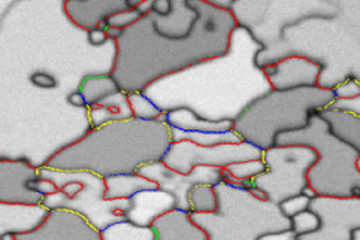All genres
81.
Talk
Computerunterstützte Thermodynamik. Kontaktstudium Werkstofftechnik Stahl, Teil I: Grundlagen, Aachen, Germany (2003)
82.
Talk
Überlegungen zu Nichtgleichgewichtsumwandlungen. THERMOCALC - Anwendertreffen, Aachen, Germany (2003)
83.
Talk
Phase Equilibria in the Ternary Fe–Rh–Ti System. TMS Annual Meeting 2003, International Symposium on Intermetallic and Advanced Metallic Materials – A Symposium dedicated to Dr. C.T. Liu, San Diego, CA, USA (2003)
84.
Talk
Carburisation of Fe3Al-based alloys in CO–H2–H2O mixtures. EFC-Workshop: Metal Dusting, Carburisation and Nitridation, Frankfurt, Germany (2003)
85.
Talk
Metal dusting of iron in CO–H2–H2O mixtures at 700 °C. EFC-Workshop: Metal Dusting, Carburisation and Nitridation, Frankfurt, Germany (2003)
86.
Talk
Martensitic/Ferritic Super Heat-Resistant 650°C Steels - Design and Testing of Model Alloys. The First International Conference on Advanced Structural Steels (ICASS 2002), Tsukuba, Japan (2002)
87.
Talk
Experimental Investigation of High Temperature Equilibria in the Ti–Al System. CALPHAD XXII, Salou, Spain (1993)
88.
Talk
Experimentelle Bestimmung der Phasengleichgewichte in den Systemen Fe–Al–Ti und Fe–Al–Cr. 15. Vortragsveranstaltung des DVM Arbeitskreises Rastermikroskopie in der Materialprüfung, Kassel, Germany (1992)
89.
Poster
Physical Metallurgy of Segregation and Austenite Reversion in Medium Mn Steels. TMS 2018 Annual Meeting & Exhibition, Phoenix, AZ, USA (2018)
90.
Poster
Physical Metallurgy of segregation, austenite reversion, carbide precipitation and related phenomena in medium Mn steels. Gordon Research Conference: Physical Metallurgy, Biddeford, ME, USA (2017)
91.
Poster
Tailoring multi-phase steel microstructures by controlling local chemical gradients. MSE 2014, Darmstadt, Germany (2014)
92.
Poster
Experimental determination of the Fe-W phase diagram. Euromat 2007, Nürnberg, Germany (2007)
93.
Poster
Carburisation of Fe–X (X=Si, Mo, V) diffusion couples. CALPHAD XXXV Conference, Haifa, Israel (2006)
94.
Poster
Experimental determination and Calphad modelling of the Fe-W system. Calphad XXXV, Haifa, Israel (2006)
95.
Poster
Experimental determination and thermodynamic modelling of Fe-based high-melting alloys. Calphad XXXIV, Maastricht / The Netherlands (2005)
96.
Poster
Metal dusting of Fe3Al-based alloys. Annual Meeting 2003, Symposium: International Symposium on Intermetallics and Advanced Metallic Materials, San Diego, CA, USA (2003)
97.
Poster
Thermodynamic assessment of Laves phase and µ-phase in Ta–X–V systems. CALPHAD XXXII, La Malbaie, Québec, Canada (2003)
98.
Poster
Martensitic/Ferritic Super Heat-Resistant 650 °C Steels. Materials for Advanced Power Engineering 2002 (Proc. 7th Liège Conference), Liège, Belgium (2002)
99.
Poster
Reinvestigation of Phase Equilibria in the Ti-rich Part of the Ti–Al System. Journées d´Automne 1996, Paris, France (1996)
100.
Poster
The Fe–Al–Ti System. Journées d´Automne 1996, Paris, France (1996)











